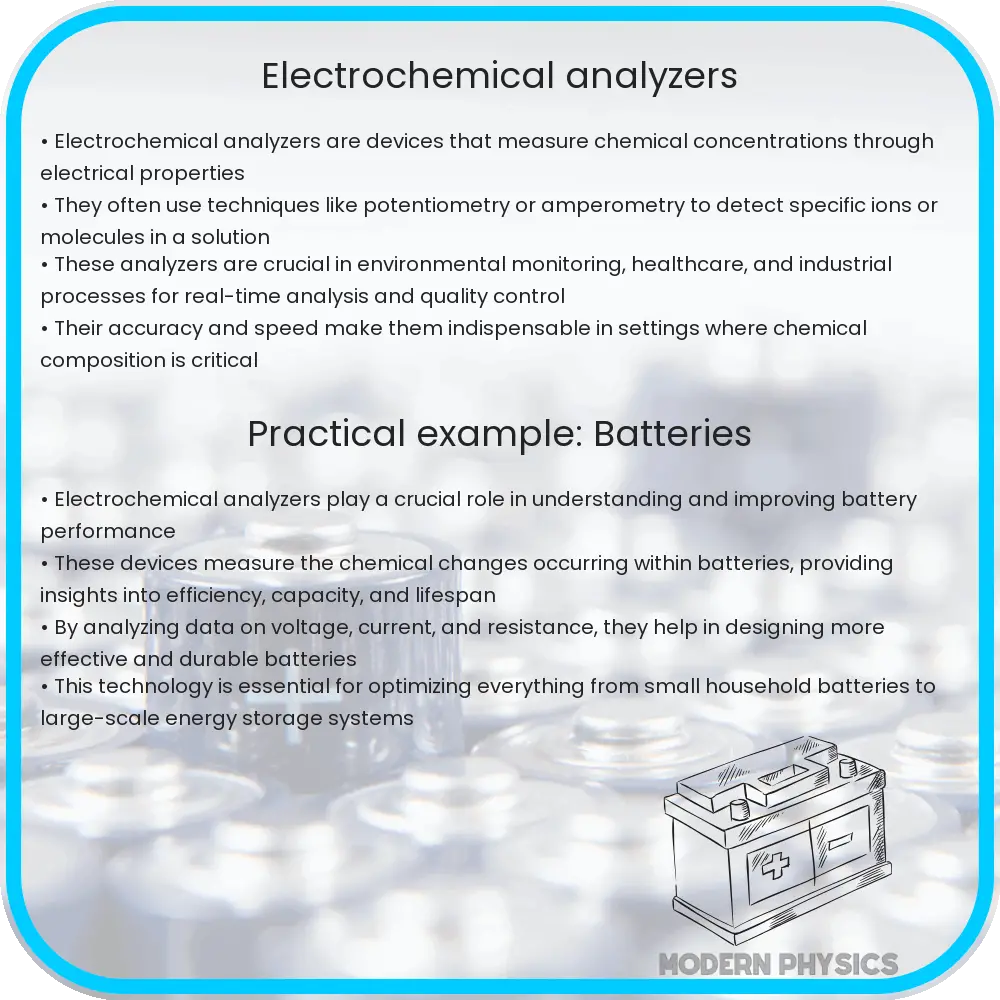Explore the functions and applications of electrochemical analyzers, essential tools for analyzing substance chemical properties using electrochemistry.

Understanding Electrochemical Analyzers: Their Precision, Efficiency, and Analytical Capabilities
Electrochemical analyzers are critical instruments used in various scientific and industrial fields for measuring and analyzing the chemical properties of substances. These devices leverage the principles of electrochemistry to detect, quantify, and monitor analytes (substances being analyzed) with precision and efficiency. Understanding how these analyzers work and their application scope can greatly enhance our appreciation of modern analytical techniques.
The Basics of Electrochemical Analysis
At its core, electrochemical analysis involves the measurement of electrical properties such as current, voltage, and resistance, and correlating these properties to chemical characteristics of a solution. The process typically involves two key components: electrodes and an electrolyte. Electrodes provide the interface where the electrochemical reactions occur, and the electrolyte is the medium that facilitates ion transport between electrodes.
The fundamental reaction in any electrochemical process can be represented as:
Oxidation-reduction (redox) reaction:
Reduction at Cathode: A+ + e– → A
Oxidation at Anode: B → B+ + e–
These reactions at electrodes can produce measurable currents proportional to the concentration of specific analytes in the solution, making it possible to perform quantitative analysis.
Types of Electrochemical Analyzers
Electrochemical analyzers come in various types, each suited for different applications based on the sensitivity and specificity required:
- Potentiostats – Control the voltage between the working and reference electrodes and measure the resulting current. These are essential for techniques like cyclic voltammetry or chronoamperometry.
- Galvanostats – Control the current between electrodes while measuring the voltage difference. These analyzers are crucial for conducting controlled current experiments such as electroplating.
- Impedance Analyzers – Measure the impedance of a cell, providing detailed information about the resistive and capacitive properties and are used in sensor development and corrosion analysis.
Each type of analyzer provides different insights into the electrochemical systems under study, allowing for a robust analysis of the materials and processes.
Applications of Electrochemical Analyzers
Electrochemical techniques are indispensable in many areas, including:
- Environmental Monitoring: Detection of pollutants and toxic metals in water and soil.
- Healthcare: Blood glucose monitoring and other biometric assays dependent on electrochemical sensors.
- Industrial Quality Control: Monitoring corrosion within pipes and tanks, and analyzing the plating quality of metals used in electronics manufacturing.
Through their versatility, electrochemical analyzers play a pivotal role in both maintaining and enhancing quality and safety standards in these critical fields.
Precision and Accuracy in Electrochemical Analysis
One of the key strengths of electrochemical analyzers is their precision and accuracy. The accuracy of these instruments is influenced by several factors, including electrode design, the stability of the reference electrode, and the quality of the electrolyte solution. To maintain high accuracy, regular calibration using standard solutions known concentrations is essential.
Precision, on the other hand, relates to the reproducibility of results under unchanged conditions. Advances in microfabrication and digital electronics have significantly improved the precision of electrochemical devices, enabling more reliable and repeatable measurements.
Maintaining Electrochemical Analyzers
Maintaining the performance and longevity of electrochemical analyzers is crucial for ensuring consistent, accurate results over time. Routine maintenance tasks include cleaning electrodes, replacing the electrolyte solution, and calibrating the system periodically. Special attention should be given to the electrodes, as their condition directly affects the accuracy and sensitivity of measurements.
It is also important to properly store the electrodes when not in use to prevent corrosion or contamination. Training users in the proper operation of these devices and implementing regular checks can prevent operational errors and extend the equipment’s life span.
Future Trends in Electrochemical Analysis
The field of electrochemical analysis is rapidly evolving, driven by advancements in technology and increasing demand for faster, more portable, and more sensitive diagnostic tools. Future trends include the development of miniaturized, wireless electrochemical analyzers that can be used in the field or integrated into wearable devices for real-time health monitoring.
Moreover, improvements in materials science are leading to the development of more robust and efficient electrodes that can operate under a wider range of conditions. Such innovations are poised to expand the applicability of electrochemical analysis in environmental, industrial, and healthcare settings.
Conclusion
Electrochemical analyzers are indispensable tools in the modern scientific and industrial landscape, offering a blend of precision, efficiency, and versatility. Their ability to accurately detect and analyze chemical properties through electrochemical reactions makes them valuable in numerous applications, from environmental monitoring to healthcare diagnostics.
Understanding the principles, types, and applications of these analyzers, as well as maintaining them properly, are essential for leveraging their capabilities fully. With ongoing technological advancements, electrochemical analysis is set to become even more integral to various fields, contributing to innovations and better standards of living. By staying informed about these tools, we can more effectively harness their potential and continue pushing the boundaries of what is scientifically achievable.
